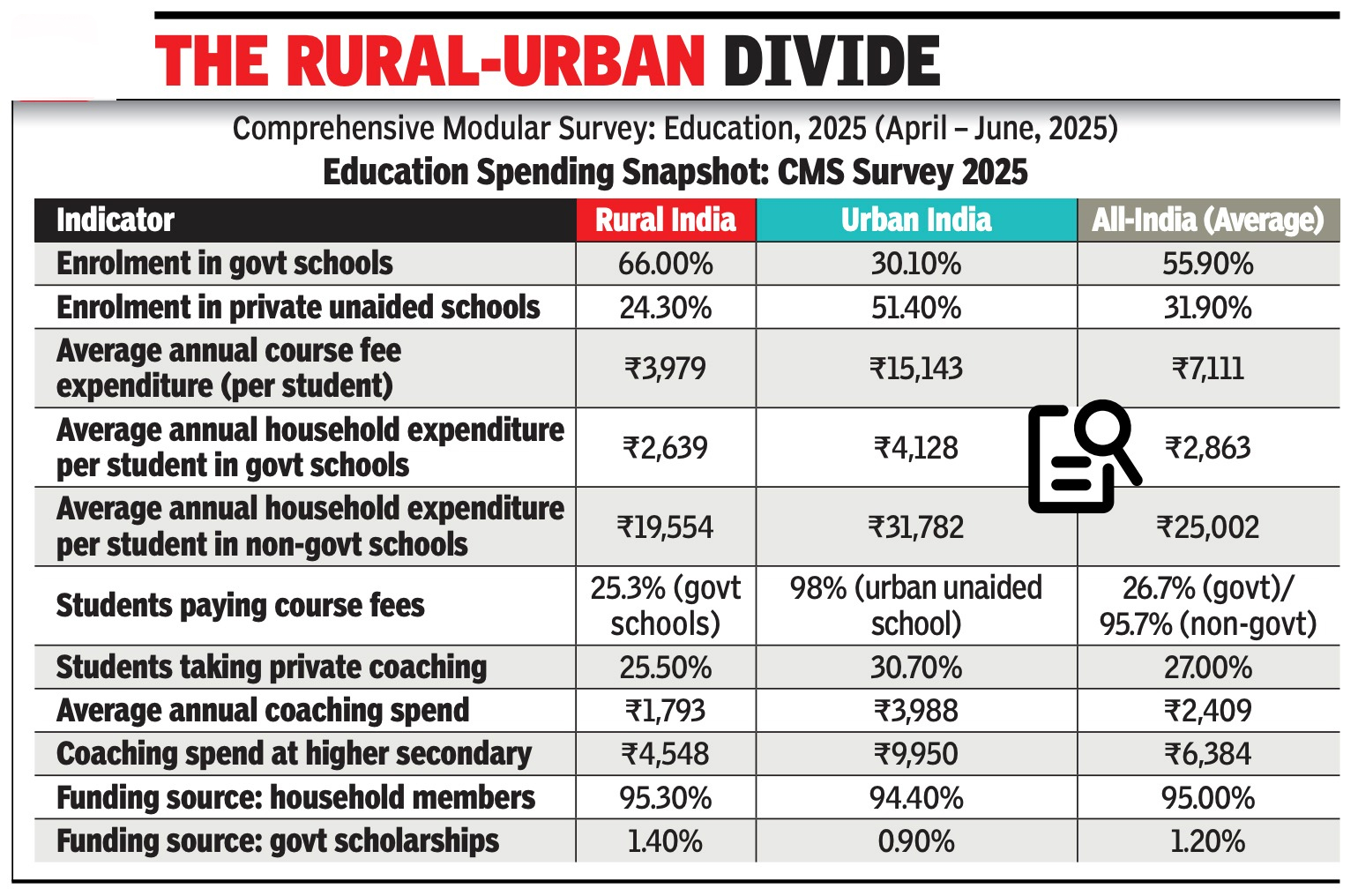Context:
The Ministry of Statistics and Programme Implementation (MoSPI) has released the Comprehensive Modular Survey: Education (CMS:E), 2025, which provides insights into household expenditure on school education in India.
Key findings:
· Dominance of Government Schools: Government schools account for 55.9% of total enrollments, with a higher percentage in rural areas (66%) compared to urban areas (30.1%).
· Expenditure Patterns: The average expenditure per student on school education in government schools is ₹2,863, while it is significantly higher in non-government schools (₹25,002).
· Private Coaching: Nearly a third of all students (27%) take private coaching, with urban areas having a higher percentage (30.7%) compared to rural areas (25.5%).
· Funding Sources: 95% of students reported that the first major source of funding for school education was from other household members, while only 1.2% reported government scholarships.
Disparities in Expenditure:
· Urban vs. Rural Expenditure: Urban households spend significantly more on course fees (₹15,143) compared to rural households (₹3,979).
· Private Coaching Expenses: Urban households spend nearly double on private coaching (₹3,988) compared to rural households (₹1,793).
Implications:
· Policy Implications: The survey's findings have important implications for education policy, particularly in addressing disparities in access to quality education.
· Government Initiatives: The government may need to consider initiatives to bridge the gap in education expenditure and access to quality education, especially in rural areas
Key Initiatives & Programs for school education in India:
1. National Education Policy (NEP) 2020
-
- Foundational policy to reform school and higher education.
- Promotes flexibility, competency-based learning, and quality enhancement.
- Foundational policy to reform school and higher education.
2. PM SHRI Schools (Schools for Rising India)
-
- Centrally sponsored scheme.
- Aims to develop 14,500 exemplar schools for showcasing NEP 2020 implementation.
- Centrally sponsored scheme.
3. NIPUN Bharat Mission
-
- Launched under Samagra Shiksha Abhiyan.
- Objective: Ensure Foundational Literacy and Numeracy (FLN) for all children by Grade 3 by 2026-27.
- Launched under Samagra Shiksha Abhiyan.
4. DIKSHA (Digital Infrastructure for Knowledge Sharing)
-
- National platform for:
- Teacher training (e.g., NISHTHA).
- Access to e-content, especially FLN-related modules.
- Teacher training (e.g., NISHTHA).
- National platform for:
5. National Curriculum Framework (NCF)
-
- Curriculum redesign to promote:
- Experiential learning
- Competency-based learning
- Alignment with NEP 2020 goals.
- Experiential learning
- Curriculum redesign to promote:
6. PM e-Vidya
-
- Integrates all digital/online education efforts.
- Multi-modal access through:
- DTH TV channels
- Radio
- ICT labs and online platforms.
- DTH TV channels
- Integrates all digital/online education efforts.
7. ULLAS (Understanding of Lifelong Learning for All in Society)
-
- Under Nav Bharat Saaksharta Karyakram (New India Literacy Programme).
- Promotes lifelong learning and adult literacy.
- Under Nav Bharat Saaksharta Karyakram (New India Literacy Programme).
Conclusion
The CMS: Education 2025 provides a clear snapshot of the financial realities of schooling in India today. With government schools serving the majority, particularly in rural areas, and household expenditure remaining relatively low in that sector, it underscores the critical role of public education in ensuring equity and access. However, the rise of private coaching and high urban expenditures also spotlight educational inequality and a growing privatization trend.







